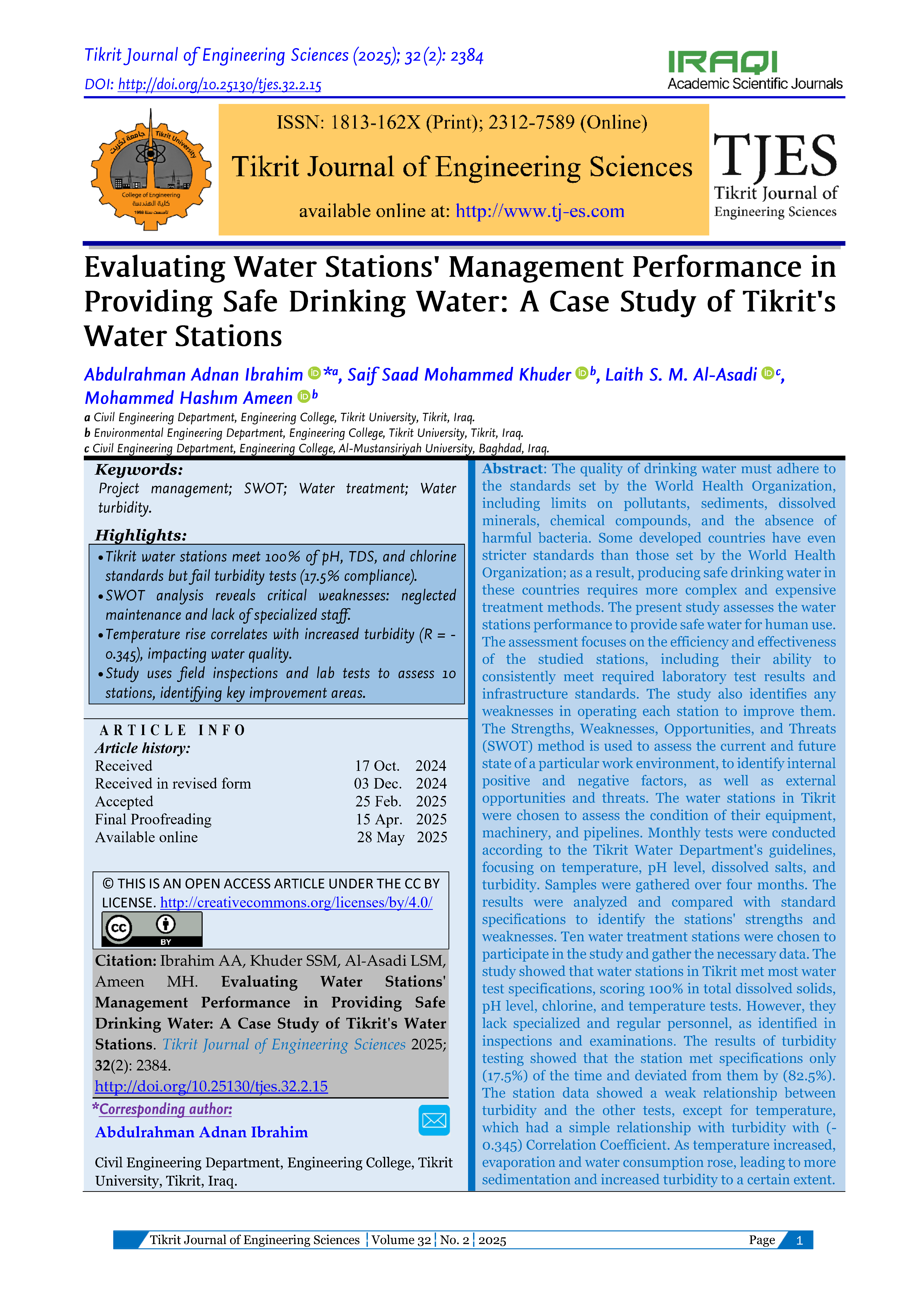Evaluating Water Stations' Management Performance in Providing Safe Drinking Water: A Case Study of Tikrit's Water Stations
Main Article Content
Abstract
The quality of drinking water must adhere to the standards set by the World Health Organization, including limits on pollutants, sediments, dissolved minerals, chemical compounds, and the absence of harmful bacteria. Some developed countries have even stricter standards than those set by the World Health Organization; as a result, producing safe drinking water in these countries requires more complex and expensive treatment methods. The present study assesses the water stations performance to provide safe water for human use. The assessment focuses on the efficiency and effectiveness of the studied stations, including their ability to consistently meet required laboratory test results and infrastructure standards. The study also identifies any weaknesses in operating each station to improve them. The Strengths, Weaknesses, Opportunities, and Threats (SWOT) method is used to assess the current and future state of a particular work environment, to identify internal positive and negative factors, as well as external opportunities and threats. The water stations in Tikrit were chosen to assess the condition of their equipment, machinery, and pipelines. Monthly tests were conducted according to the Tikrit Water Department's guidelines, focusing on temperature, pH level, dissolved salts, and turbidity. Samples were gathered over four months. The results were analyzed and compared with standard specifications to identify the stations' strengths and weaknesses. Ten water treatment stations were chosen to participate in the study and gather the necessary data. The study showed that water stations in Tikrit met most water test specifications, scoring 100% in total dissolved solids, pH level, chlorine, and temperature tests. However, they lack specialized and regular personnel, as identified in inspections and examinations. The results of turbidity testing showed that the station met specifications only (17.5%) of the time and deviated from them by (82.5%). The station data showed a weak relationship between turbidity and the other tests, except for temperature, which had a simple relationship with turbidity with (-0.345) Correlation Coefficient. As temperature increased, evaporation and water consumption rose, leading to more sedimentation and increased turbidity to a certain extent.
Article Details
Section

This work is licensed under a Creative Commons Attribution 4.0 International License.
THIS IS AN OPEN ACCESS ARTICLE UNDER THE CC BY LICENSE http://creativecommons.org/licenses/by/4.0/
References
Boyd CE. Water Quality: An Introduction. Springer Nature; 2019.
Elzagheid M. Water Chemistry, Analysis and Treatment: Pollutants, Microbial Contaminants, Water and Wastewater Treatment. Walter de Gruyter GmbH & Co KG; 2023.
Evaluation of the Efficiency of Gas Al-Shamal Water Treatment Plant. Diyala Journal of Engineering Sciences 2015:1-12.
Issa HM. Evaluation of Water Quality and Performance for a Water Treatment Plant: Khanaqin City as a Case Study. Journal of Garmian University 2017; 3(12):802-821.
Al-Tamir MA. The Situation of Water Treatment Plant in Mosul City. Al-Rafidain Engineering Journal (AREJ) 2019; 24(2):138-145.
Tebbutt THY. Principles of Water Quality Control. Elsevier; 2013.
Brandt MJ, Johnson KM, Elphinston AJ, Ratnayaka DD. Twort's Water Supply. Butterworth-Heinemann; 2016.
El Batouti M, Al-Harby NF, Elewa MM. A Review on Promising Membrane Technology Approaches for Heavy Metal Removal from Water and Wastewater to Solve Water Crisis. Water 2021; 13(22):3241.
Selman HM, Wahid AAA, Selman GM. Evaluating the Performance of Water Treatment Plant (Case Study: Al-Rumaitha Treatment Plant, Al-Muthanna, Iraq). 2015.
Sigdel B. Water Quality Measuring Station: pH, Turbidity and Temperature Measurement. 2017.
Edori O. Physical and Chemical Characteristics of Water from Ede Onyima Creek, Okarki-Engenni, Rivers State, Nigeria. Chemistry Research Journal 2020; 5(3):144-154.
Farooq S, Hashmi I, Qazi IA, Qaiser S, Rasheed S. Monitoring of Coliforms and Chlorine Residual in Water Distribution Network of Rawalpindi, Pakistan. Environmental Monitoring and Assessment 2008; 140:339-347.
Gurl E. SWOT Analysis: A Theoretical Review. 2017.
Teoli D, Sanvictores T, An J. SWOT Analysis. 2019.
Puyt RW, Lie FB, Wilderom CP. The Origins of SWOT Analysis. Long Range Planning 2023; 56(3):102304.
Zainalc K, Al-Rumaidh M. SWOT Analysis for Published Marine Scientific Research in the Kingdom of Bahrain from 1960s Through to 2011. Arab Gulf Journal of Scientific Research 2012; 30.
Stehlik-Barry K, Babinec AJ. Data Analysis with IBM SPSS Statistics. Packt Publishing Ltd; 2017.
Obilor EI, Amadi EC. Test for Significance of Pearson’s Correlation Coefficient. International Journal of Innovative Mathematics, Statistics & Energy Policies 2018; 6(1):11-23.
Khuder SSM, Ibrahim ARA, Eedan OAAA-A. A System to Determine the Effect of Change Order for Roads Projects on Execution Time. Tikrit Journal of Engineering Sciences 2022; 29(1):26-35.
Khuder SSM, Ibrahim AA, Eedan OAAA-A. Adopting a Method for Calculating the Impact of Change Orders on the Time It Takes to Complete Bridge Projects. Iraqi Journal of Civil Engineering 2022; 15(2):52-58.





